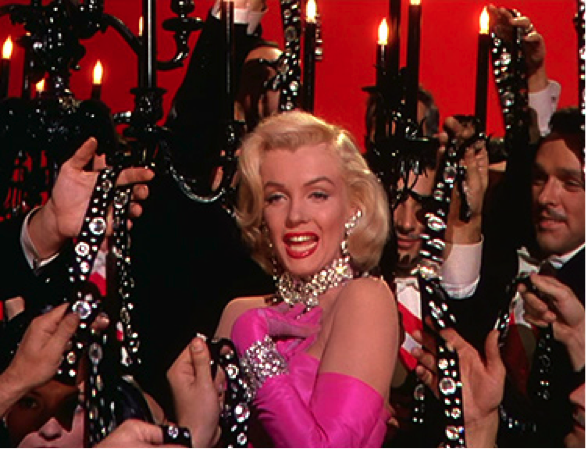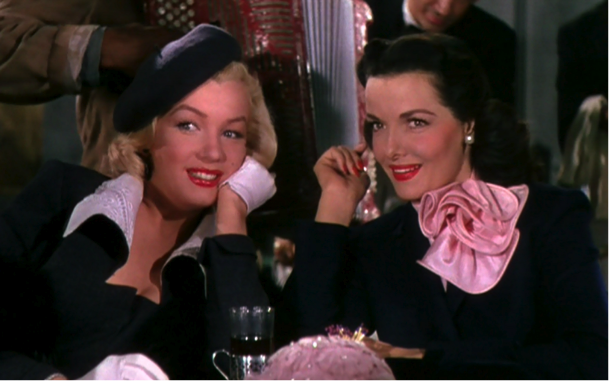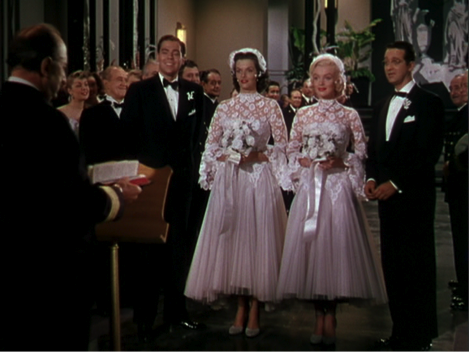Queering Classic Hollywood: Girls are a Girl’s Best Friend
There is a practical (if not exactly admirable) logic to “Diamonds are a Girl’s Best Friend” in Gentlemen Prefer Blondes (1953). Even though the song justifies a stereotypical gold-digger mentality, there is truth to its lessons. There have always been plenty of examples of the ways “Men grow cold / As girls grow old,” from midlife divorces and remarriages to younger women to the dearth of strong roles for actresses “of a certain age.” (A grizzled Harrison Ford is still Han Solo in his 70s, but lovely Lucy Lawless is too old to play Xena in the reboot at 40-something.)

Marilyn Monroe in Gentlemen Prefer Blondes (1953)
Whether or not we sympathize when Lorelei (Marilyn Monroe) explains to her future father-in-law that money makes a man attractive the same way youth and beauty make a woman attractive, diamonds are not truly at the heart of the film. The most important lesson Gentlemen Prefer Blondes teaches is that a “girl’s best friend” is another girl.
If gold-digger characters are antifeminist, the message that women are in competition with one another for the good life is even more so. The “don’t hate me because I’m beautiful” slogan that once graced 1970s shampoo ads has long been a part of popular cultural messages to women. In female-centered entertainment ranging from The Women (1939) to Sex and the City (1998-2004), woman-on-woman antagonism is treated as normative, unavoidable and occasionally even admirable. When The Women’s ladylike Mary Haines (Norma Shearer) wins her “Adonis” of a husband back from his adulterous relationship with shop girl Crystal Allen (Joan Crawford), for example, it’s because she’s stopped being a martyr and “grown claws” painted “jungle red.”
The denial of this message in Gentlemen Prefer Blondes is one important reason the film is such a delight. It may not pass the Bechdel Test (it’s a musical about finding heterosexual love, after all), but the scenes between Monroe’s Lorelei Lee and Jane Russell’s Dorothy Shaw consistently illustrate sincere affection, nurturance and pleasure in each other’s company. They enjoy their stage career together, singing songs such as the opening number, “Two Little Girls from Little Rock,” that reveal their shared working-class background and future ambitions (more Lorelei’s than Dorothy’s perhaps, but they both love to dress up and strut their stuff). And they express care over each other’s choices and actions. Dorothy worries over Lorelei’s obsession with money; Lorelei fears Dorothy’s lack of concern over it. Each wants the other to find the “right” man and to settle for nothing less. They work together to ensure this, especially as Dorothy deals with Ernie Malone (Elliot Reid), who woos her yet judges her friendship with Lorelei. Dorothy refuses to put up with his attacks—one of the rare examples of a romantic comedy in which friendship quashes romance, at least temporarily.

Marilyn Monroe and Jane Russell in Gentlemen Prefer Blondes (1953)
We do end up with a traditional “happily ever after” in a double wedding at the film’s conclusion, but is everything as heteronormative as it seems? As I’ve noted, the strength of the women’s friendship exceeds the traditional boundaries of classic Hollywood romantic comedy, and the imagery of the final scene provides us a possible queer interpretation that the narrative does not. Dorothy and Lorelei walk down the aisle elbow to elbow, looking out at the attendees as their fiancés gaze at their beloveds in matching dresses, shoes and hats, and with identical bouquets. The appeal is sisterly, twin-like, but can also be read as lesbian, for Dorothy and Lorelei look as if they are marrying one another. Bisexual is perhaps most appropriate in describing the way the two couples line up before the justice of the peace—with the women remaining together, the men flanking them on the outside—as Alexander Doty contends in “Everyone’s Here for Love: Bisexuality and Gentlemen Prefer Blondes,” a chapter in his collection Flaming Classics: Queering the Film Canon. In particular, Doty persuasively links the film’s insistence on the primacy of both same-sex and opposite-sex relations to the way mainstream films appeal to diverse audiences to maximize profit. Gentlemen Prefer Blondes can be read as entirely heterosexual or quite queer, depending on one’s viewing practices and preferences. The queer reading of a classic Hollywood film will rely on more subtle cues and codes than will the heteronormative, but some films are more subtle than others. Gentlemen Prefer Blondes, to my mind, is decidedly and happily not.

Marilyn Monroe and Dorothy Shaw at the end of Gentlemen Prefer Blondes (1953)

